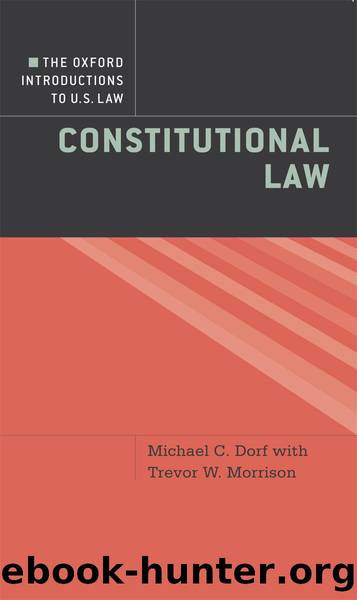The Oxford Introductions to U.S. Law by Dorf Michael C.; Morrison Trevor W.; & Trevor W. Morrison

Author:Dorf, Michael C.; Morrison, Trevor W.; & Trevor W. Morrison
Language: eng
Format: epub
Publisher: Oxford University Press
Published: 2010-08-14T16:00:00+00:00
Tiers of Scrutiny
As we explained in Chapter 3, the post-New Deal Supreme Court has made deference to political actors the default setting of American constitutional law. Nearly all laws and policies can be challenged as drawing unfair distinctions or unduly infringing liberty. But if the courts are not to usurp the legislative role, they must be prepared to reject most such challenges. In its interpretation of both equal protection and due process (which we discuss in Chapter 8), the courts grant deference via the “rational basis” test. To prevail in a claim that some law or policy denies her equal protection, a litigant must show that the law or policy is not “rational.” Under this standard, the fit between means and ends need not be perfect. Indeed, under the rational basis test, the fit need not even exist: So long as the court can imagine a state of facts that would render the challenged law or policy rational, the challenge will fail.
New York City Transit Authority v. Beazer nicely illustrates the rational basis test. A blanket rule forbade drug users from working in the New York City subway and bus system. The rule was challenged by recovering heroin addicts who legally used methadone, a drug that satisfies cravings without producing euphoria. Evidence adduced in the trial court and credited by the Supreme Court showed that recovering heroin addicts who had been successfully maintained on methadone for a year or longer were no less qualified to work for the Transit Authority than persons who used no drugs. Nonetheless, the Supreme Court rejected the challenge as raising only policy questions. The Transit Authority could have made some exceptions to its blanket policy for methadone users without ill effect, but that was not a matter of constitutional obligation. “No matter how unwise it may be for [the Transit Authority] to refuse employment to individual car cleaners, track repairmen, or bus drivers simply because they are receiving methadone treatment,” the Court ruled, “the Constitution does not authorize a federal court to interfere in that policy decision.”44
In Beazer and other cases, before the courts apply the deferential rational basis test, they must first conclude that the challenged law or policy does not employ an invidious criterion. Laws that discriminate based on “suspect classifications” such as race do not trigger the deferential rational basis test but the demanding strict scrutiny test.
It is not difficult to name the classifications that the Supreme Court has deemed suspect, thus triggering strict scrutiny. Race, ethnicity, national origin (as distinct from nationality), and religion are suspect classifications, as is alienage in some contexts.45 Sex has been described as “semi-suspect,”46 and thus a trigger for intermediate rather than strict scrutiny. Federal, state, and local antidiscrimination laws protect against age and disability discrimination, but the Court has found neither category suspect or semi-suspect. As this book goes to press, the Court has not clearly said that sexual orientation discrimination triggers heightened scrutiny, either in its own right or as a form of sex discrimination.
Download
This site does not store any files on its server. We only index and link to content provided by other sites. Please contact the content providers to delete copyright contents if any and email us, we'll remove relevant links or contents immediately.
Master of the Game by Sidney Sheldon(2184)
GRE Premier 2017 with 6 Practice Tests by Kaplan(1733)
Law School Essays that Made a Difference by Princeton Review(1721)
Law: A Very Short Introduction by Raymond Wacks(1635)
A Life of Crime by Harry Ognall(1596)
Objection! by Nancy Grace(1569)
College Essays that Made a Difference by Princeton Review(1551)
Examples & Explanations: Administrative Law by William F. Funk & Richard H. Seamon(1550)
Philosophy of law a very short introduction by Raymond Wacks(1541)
Writing to Win: The Legal Writer by Steven D. Stark(1497)
Cracking the SAT Premium Edition with 6 Practice Tests, 2017 by Princeton Review(1480)
Civil Procedure (Aspen Casebooks) by Stephen C. Yeazell(1440)
Sidney Sheldon (1982) Master Of The Game by Sidney Sheldon(1424)
GMAT For Dummies by Lisa Zimmer Hatch & Scott A. Hatch(1420)
Drafting Contracts: How and Why Lawyers Do What They Do, Second Edition by Stark Tina L(1403)
Storytelling for Lawyers by Meyer Philip(1366)
So You Want to be a Lawyer by Lisa Fairchild Jones Esq(1327)
Graduate Admissions Essays, Fourth Edition: Write Your Way into the Graduate School of Your Choice by Donald Asher(1311)
INDEFENSIBLE: One Lawyer's Journey Into the Inferno of American Justice by Feige David(1195)
